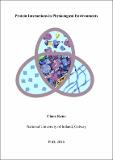| dc.contributor.advisor | Crowley, Peter B. | |
| dc.contributor.author | Kyne, Ciara | |
| dc.date.accessioned | 2016-06-07T08:19:09Z | |
| dc.date.issued | 2016-06-03 | |
| dc.identifier.uri | http://hdl.handle.net/10379/5860 | |
| dc.description.abstract | The interactions of three proteins (ΔTat-GB1, cytochrome c and flavodoxin) were explored in Escherichia coli cells and extracts. The results indicate features of the physicochemical basis for protein assembly in the complex cytoplasm. Some of this work featured as a highlighted article in Protein Science. Although key principles of molecular recognition have been gleaned from ‘reductionist’ studies performed in dilute solution, physiologically-relevant insights require protein characterisation under native or near-native conditions. In particular, knowledge of the low specificity ‘quinary’ interactions that dynamically organise the cytoplasm is scarce. In-cell NMR indicated that all three proteins interact pervasively with the cytoplasm, despite their different sizes and surface properties. NMR, size exclusion chromatography (SEC) and/or native gel electrophoresis was used to probe the physicochemical basis for the interactions of each test protein in E. coli extracts. The charge of cytochrome c and four of its mutants was determined by membrane confined electrophoresis. These findings indicate the effects of decreased charge on
cytochrome c interactions in extracts. The weak, low-specificity cytochrome c-flavodoxin complex was studied in volume-occupied solutions to dissect the effectsof the cytoplasmic architectures on this ‘quinary-like’ interaction. The intricate interplay of charge, hydrophobic interactions and preferential hydration in governing cytoplasmic interactions is emphasised. These findings provide fresh evidence in support of a physicochemical model for cytoplasmic structuring. A novel strategy for 19F tryptophan incorporation in E. coli was also developed which involved the addition of 30-60 mg/L of the tryptophan precursor 5-fluoroindole to the growth medium. 19F tryptophan-labelled flavodoxin and GB1 were subsequently studied by 19F NMR in E. coli or extracts. | en_IE |
| dc.rights | Attribution-NonCommercial-NoDerivs 3.0 Ireland | |
| dc.rights.uri | https://creativecommons.org/licenses/by-nc-nd/3.0/ie/ | |
| dc.subject | Protein interactions | en_IE |
| dc.subject | NMR spectroscopy | en_IE |
| dc.subject | In-cell NMR | en_IE |
| dc.subject | Cell extracts | en_IE |
| dc.subject | Quinary structure | en_IE |
| dc.subject | Molecular recognition | en_IE |
| dc.subject | Chemistry | en_IE |
| dc.title | Protein interactions in physiological environments | en_IE |
| dc.type | Thesis | en_IE |
| dc.contributor.funder | NUI Galway Hardiman Scholarship | en_IE |
| dc.contributor.funder | NUI Travelling Studentship | en_IE |
| dc.local.note | The interactions of three proteins (ΔTat-GB1, cytochrome c and flavodoxin) were explored in Escherichia coli cells and extracts. The results indicate features of the physicochemical basis for protein assembly in the complex cytoplasm. Some of this work featured as a highlighted article in Protein Science. | en_IE |
| dc.description.embargo | 2017-06-03 | |
| dc.local.final | Yes | en_IE |
| nui.item.downloads | 555 | |


